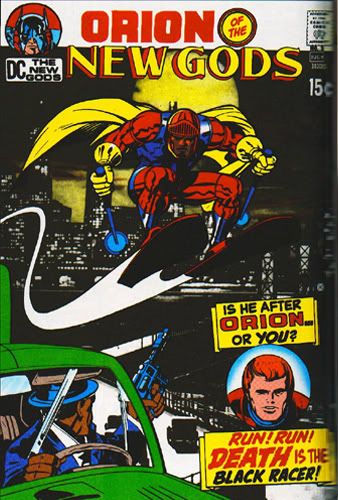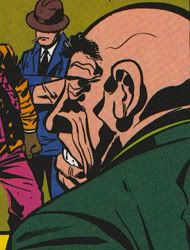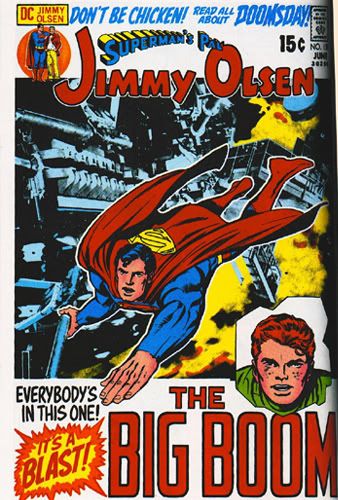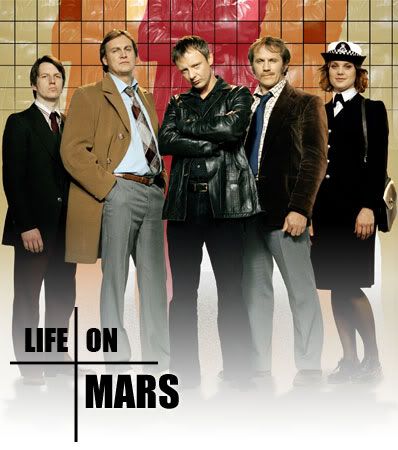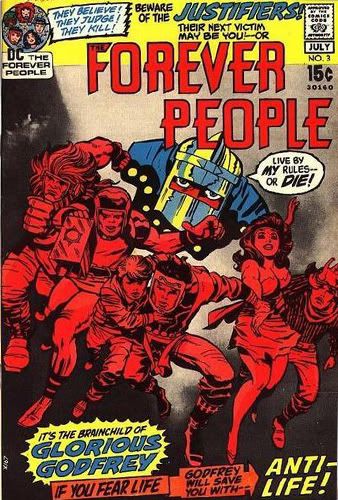
You probably don't need me to describe the many and various ways in which comics' growth were stunted over the decades. The long and the short of it is that being confined to disposable kid's entertainment for so long meant that the innovators often weren't quite able to shake off the status quo when attempting to do something "important" and "meaningful" within the comics medium. This was probably most evident in the early 70s, when comics started to enter a true adolescent phase--meaning that they started yearning for "adulthood" (being treated as a respectable medium) but, for the most part, weren't sophisticated enough to know how to go about it. The results were often strange, to say the least. This is the era in which Spidey bucked the comics code by having a friend fall to heroin addiction, Steve Ditko created a string of Objectivist superheroes, and Green Lantern and Green Arrow teamed up for a really heavy-handed commentary on America and everything that was wrong with it. The results fluctuated between "interesting" and "painfully self-important", but the fact of the matter is, trying to shoehorn "serious issues" into what had until very recently been a defiantly juvenile genre was a very ill fit. It would take a lot of tinkering before we started to get superheroes who could mesh comfortably with the "real world" and all its messiness, and some would argue that we never really got there.
Kirby, ambitious scamp that he was, was not immune to this impulse--in fact, he and Stan Lee had essentially opened the floodgates with their original Marvel line-up (which, let's not forget, included a weapons manufacturer who was a POW in Vietnam and a gang of mutants constantly on the run from prejudice). The main difference there, though, was that the politics were just part of the backdrop, spice to stories that were otherwise focused on the important business of long underwear types beating each other up. When superhero comic writers moved political commentary to the fore, they were generally unable to deal with it except in the straightforward, black-and-white, over-the-top manner in which they'd handled alien invasions and world-shattering conflicts.
Kirby was no exception to this; it's just that his world view was so vast, and so bizarre, that the Deep Important Meanings frequently went past self-importance and awkwardness and became just another ingredient in the surreal landscape of Kirby's world.
Frequently, but not always.
In
The Forever People #3, Kirby tackles an issue that's proved just a tad divisive over the years: organized religion. Given the countercultural bent I've noted so often in these essays, I don't think you'll be surprised by Kirby's take on the subject. The story starts with a quote by Adolf Hitler, an army of blank-eyed citizens spouting hatred of those who are different, and a freakishly magnetic red-haired cult leader who has them in his thrall.
What? No, it's not Jimmy Olsen! It's
Glorious Godfrey, who makes no secret of his Apokaliptish affiliation, his reverence for Darkseid, and his worship of the Anti-Life equation. The only thing remotely subtle about this four-page sequence is that Kirby doesn't outright refer to Godfrey as a religious leader. But come on: the guy's followers meet in a giant tent containing a huge organ, and Godfrey wears white, billowing robes while standing at a pulpit. And his name is
God-Free. I'm kind of surprised there wasn't more of an uproar over this comic, but then, this wasn't the 50s, with Wertham and whatnot. This was the 70s, and America had a lot more to worry about than some subversive comics.
"Life has pitfalls! Anti-life is protection!" Proclaim the unsubtle banners toted by Godfrey's followers. "Life will make you doubt! Anti-life will make you
right!" And, most crucially, "You can justify
anything with anti-life!" More on this in a moment, but for now, you can see how this relates to what I was talking about, above. No real wannabe totalitarian would advertise himself as promoting "anti-life" or honk on about how he was giving you the right to kill and inflict pain. Real-world villains always make it about something else, something that nobody could disagree with, while sneaking in their more pernicious and mean-spirited views in a roundabout way. But because this is a comic, we have to have it spelled out in broad strokes.
But while he may have been unsubtle, Kirby was canny. Godfrey's creating an army of "Justifiers" who do his bidding mindlessly--the name coming from their ability to justify doing anything in the name of Godfrey, Darkseid, and Anti-Life. It's still cartoonish, but that is pretty bang-on. Kirby's point is that a lot of religious fanatics are concerned less about doing whatever's necessary to save their souls than about using their religion to justify their own violent or hate-filled impulses. I'm having a hard time arguing with that viewpoint, personally...
On literally the next page, we see Godfrey's methods bear bitter fruit for our heroes. With no explanation, a Justifier stands in the middle of our hairy, unwashed heroes' new home base, shaking down lil' Donnie--that's the Tiny Tim lookalike from the last issue, remember him?--and demanding to know where the Forever People are, despite the fact that they're standing right behind him. "
Motherbox has
bent the light around us--
scattered the sound vibrations!" Explains Vykin hurriedly. Oh, OK...that explains one aspect of this scene. But how did this guy get in? How did he know the Forever People lived there in the first place? And if his bosses knew, why did they send a single guy, instead of an onslaught of Justifiers?
Well, we get a partial explanation for that last one, as the Forev Peeps rescue Donnie and bail out of the apartment (Big Bear literally goes through the wall.) See, the Justifier is carrying an Apokoliptish bomb, and he's capable of, as Beautiful Dreamer reminds us, justifying his own death. Yes, that's right: the Justifier is a suicide bomber. Ouch. That's almost painfully prescient.
The FPs just barely escape by diving into a convenient bulldozer-dug hole, and pause to reconnoiter. Realizing that the Apokolips war/invasion has begun in earnest, and that there'll be no more zany hippie monkeyshines for them, the gang decides to abandon the apartment they spent much of last issue furnishing, and hit the road. Well, the apartment is pretty much a smoking crater by now anyway, but even if it wasn't it would still be the right decision. Having these guys hang around the poor neighbourhood of Genericburg isn't nearly as interesting as having them pull an Easy Rider and take a trek across that weird old America. Which is especially weird when Kirby's drawing it.
This, of course, means they have to abandon Donnie. HOORAY!!!!
Sorry to be so blunt about it, but it doesn't seem like a particularly emotional parting for the FPs, either:
BIG BEAR: On board! On board!
BEAUTIFUL DREAMER: Goodbye, Donnie! We leave you what
cannot die--
love! Friendship! SERAFIN: It is so in
New Genesis! It can be
here!DONNIE: You must come back! You must!
BIG BEAR: Preparing for
phase-out!And then, in a flurry of really dumb technobabble and paying no further heed to Donnie whatsoever, the FPs blast off into the sky.
Good thing, too, because the Justifiers are about to launch their attack on the city. Declaring that "the people we've chosen as targets live here," the Justies pour out of their flying box in a wave of dickishness:
JUSTIFIER #1:
Don't bother to discrminate! The women and children are as hated as the men!
JUSTIFIER #2: Waste
no time on mercy!
Drag them out! Treat them
rough!JUSTIFIER #3:
Listen to their cries! I've been
waiting to do this for years!
JUSTIFIER #4: Get going! We'll
show what we do with your kind!
Man, dig that naturalistic dialogue. I know
I've been wasting entirely too much time on mercy these days. Many's the morning where I'll just sit in my breakfast nook, unable to get going on the day's work, because I'm just feeling too darn merciful.
Seriously though, what "kind" are we talking about here? Nothing's specified, and for once I think that has less to do with Kirby's awkward writing style than the fact that he wanted to tiptoe around editorial and the comics code. The obvious suggestion is that the Justifiers are Nazi-ish, which would make the people they're rounding up Jews (of which, I need hardly remind you, Kirby was one). But like I said above, everything else in the book points to the Justifiers being religious cultists, and the comparisons to totalitarianism aren't helped by the fact that the Justifiers mention repeatedly that they want to avoid the police. Oh, and the quasi-medieval clothing seems more Spanish Inquisition than Fourth Reich, too. Though I guess those guys weren't fond of the Jews either.
There's also a brief nod to Fahrenheit 451, as a Justifier enters a library and torches it with a flamethrower, to prevent the spread of dangerous ideas. That would be somewhat more effective if there weren't thousands of other libraries throughout the country, but OK. Godfrey watches through his dressing room mirror-slash-omniscient viewing device as another one defaces a store:

Well, it's still more logical than
"S" for Shakespeare. (Scroll down.)
Godfrey uses the power of technobabble to determine that the Forever People are still alive, and prepares for an invasion of tonight's ceremonies by...well, not doing anything, really. By the way, does it seem like Godfrey's assistants in the panel above are modeled after someone in the real world? I'm guessing some kind of early 70s evangelists or religious leaders. Anyone know?
The FPs land just out of view of Godfrey's revival tent and do what they always do: call on Deus Ex Machina Man, I mean Infinity Man, to solve everything. This month, Infy can pass through solid rock at will, and bend lasers--or rather, "Omega beams"--fired at him by the Justifiers, turning them back on his enemies.
"You
fool!" Cries Godfrey to Infy's back. "Do you think your spectacular
gimmickry can stop this operation?" Huh, apparently Godfrey likes to compliment people as he's insulting them.
GODFREY: The forces of
Apokolips are many! --And
mighty!INFINITY MAN: Your secret is
wind, Godfrey! An
evil wind that rushes from your
throat--
Lord, I
hope it's from your throat...
INFINITY MAN: --And this
Demon's organ! Which must be
destroyed!Ooooooh, I get it. It was the organ all along!
Actually, that's kind of interesting--the Apokoliptians are seeking the Anti-Life Equation, which will make everyone do their bidding, but it seems like Godfrey's organ got them pretty close already. Granted, properly deployed, the Equation can control everyone in the
Universe, but still, it seems to me, just follow the Borg model of assimilating everyone into Justifiers, and you've got a pretty good head start. Except Infinity Man just smashed the organ, so back to square one, I guess.
SUDDENLY! An ominous gloved hand lands on Infy's shoulder! "Turn about!
Look at me!" Instead of spinning and punching him in the face, Infy looks vaguely up and to the left and soliloquizes. "That
voice! It
chills the spirit--like the coming
doom of all living things!" It's Darkseid, natch...he just happened to be in the neighbourhood, apparently. Or, OK, I guess this is what Godfrey did to prepare for Infinity Man's incursion: called the boss to help him. Fine, fine, whatever.
Anyway, Darkseid shoots cheesy beams into Infy's eyes--through his goggles, yet--and disburses him back into the various Forever People. Apparently the power of cosmic love from beyond infinity is still no match for Darkseid. Or else the plot required him to take a dive.
No sooner have the Forev Peeps reappeared than Desaad pops up and neutralizes them all with a "nerve beam" which, we're told, causes them to yelp loudly before they collapse. We're told this because Kirby apparently couldn't be bothered to draw it, which is weird given that he proceeds to devote the remaining three pages to Darkseid describing the plan he's been implementing for ten issues now, Godfrey jealously vying with DeSaad for Darkseid's favour, and Desaad cacklingly describing the horror that awaits the FPs in his "Camp".
So, at the end of the day, I'd say Kirby pulls off tackling deeper subjects pretty well, without forgetting to give us a neat comic book. Furthermore, with the FPs leaving their pad behind and hitting the road, the book finds its groove. And on top of that, it's a neat cliffhanger in which Infinity Man, for once, doesn't provide a magic solution to the gang's woes. You can definitely sense Kirby finding his feet and gaining in confidence.
The next couple of issues of The Forever People continue the trend of satire and social commentary. Will Kirby lose his way, or gather steam? Stay tuned, true believers...

